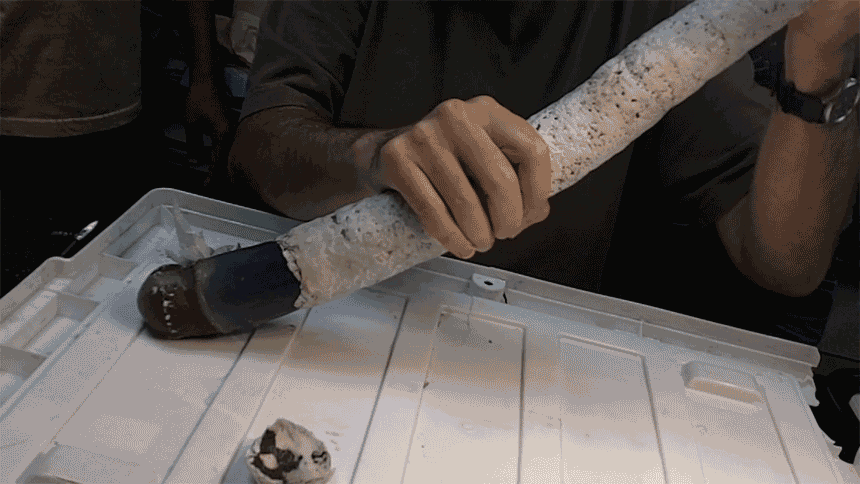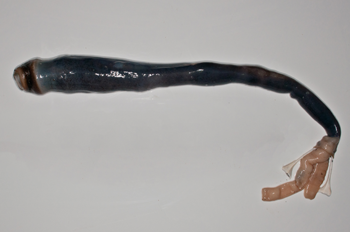Weird mega-worm found to have odd diet
Researchers get their first look at giant clam and its unusual food source

A scientist reveals the giant 'worm' that was hidden inside a hard shell.
University of Utah
A bizarre giant wormlike creature has finally given up some of its secrets. It doesn’t eat using its mouth. Instead, microbes feed these 1.5-meter- (5-foot-) long black shipworms. For the first time, researchers have examined the animal that normally lives within a hard tusklike shell. And they find it’s lost any use for its digestive organs, thanks to the food it now derives from bacteria living in its gills.
“Shipworms are common in the Philippines and people eat them as a delicacy,” notes Margo Haygood at the University of Utah in Salt Lake City. But she’s referring to the small types. They tend to be only about 5 centimeters (2 inches) long. They eat wood from ships and from trees that have washed into the ocean. Indeed, that’s how they got their name.
Her team’s new data show that the giant shipworms evolved traits quite different from their smaller kin. What’s more, Haygood notes, even people in the Philippines “were unfamiliar with this giant one that lives in the mud.”
For 300 years, scientists had known of the strange giant (Kuphus polythalamia). Although a clam, its long, thin body makes most people mistake it for a worm. “It’s one of these mysterious creatures we know exists but is hard to find,” she explains. “They seem to live in rare and remote areas of the ocean.” There, they live half buried in mud.
Haygood teamed up with other researchers from the United States and the Philippines to track down and examine for the first time unshelled giant shipworms. On April 17, the group shared what it learned from these creatures in the Proceedings of the National Academy of Sciences.
Cracking open a surprise
While searching for the animals, the scientists caught a lucky break. A researcher who knew some of Haygood’s colleagues happened to be watching a television documentary about giant shipworms.
That video showed the animals planted, like carrots, in the mud of a shallow lagoon. Team members contacted the fisheries scientists who had been interviewed in the video. They asked where the shipworms could be found. The researchers then traveled there in 2010 and 2011.
They brought five of the animals to a lab in the Philippines. There, Daniel Distel dissected them. He’s a marine biologist at Northeastern University in Boston, Mass.

Distel started by gently tapping off the shell of one of the soft creatures. He then sliced open the animal. Its digestive organs, he found, were much smaller than would be expected for an animal its size. There was a small stomach and no sign of the wood-digesting organ found in other shipworms. Even the animal’s intestine was very short. Further research would show the animal had little need for these.
Unlike most animals, giant shipworms don’t take food into their mouths and digest it. Instead, they rely on bacteria that live in their gills. These microbes make food for their giant hosts.
The bacteria normally live in stinky mud on the bottom of the seafloor. That mud contains hydrogen sulfide, a chemical that has the odor of rotten eggs. The bacteria use the chemical to help make carbon compounds. Then they feed those carbon-based materials to their big hosts.
As a marine microbiologist, Haygood studies how ocean microbes interact with their environment. Here, she’s been studying the bacteria that feed the giant shipworms.
The food these bacteria produce “likely goes directly into [the shipworms’] blood,” says Haygood. This means the animal doesn’t need the digestive organs that their small, wood-eating cousins do.” Haygood and her team suspect the giant shipworms evolved their unusual way of getting food at least one million years ago.
That evolutionary change probably gave giant shipworms an important advantage, says Nicole Dubilier. A microbiologist in Germany at the Max Planck Institute for Marine Microbiology in Bremen, she was not part of the project. “Wood is a food source that does not provide a lot of energy,” she notes. Hydrogen sulfide, though, can be used to convert carbon compounds into an energy-rich food.
“What I find fascinating,” adds Dubilier, “is that something so ugly can have such an interesting biology.”







